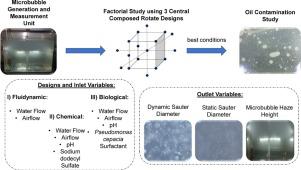Chemical Engineering Research and Design ( IF 3.7 ) Pub Date : 2021-02-19 , DOI: 10.1016/j.cherd.2021.02.015 Pedro Pinto Ferreira Brasileiro , Rita de Cássia Freire Soares da Silva , Valdemir Alexandre dos Santos , Leonie Asfora Sarubbo , Mohand Benachour

|
Microbubble flotation is a process for the treatment of oily water that requires attention to the variables of the oil removal process. In the present study, experimental designs were applied to a microbubble generation and measuring unit. The factors selected for optimization of the microbuble production were water flow rate, airflow rate, pH, and surfactant concentration. The response variables were dynamic Sauter diameter (DSD), static Sauter diameter (SSD), and microbubble haze height (MHH). Factor planning (central composite rotational design) was used to determine the behavior of the microbubbles in the absence of surfactant as the collector (fluid dynamic planning) as well as in the presence of the synthetic surfactant sodium dodecyl sulfate (chemical planning) or a microbial surfactant produced by the bacterium Pseudomonas cepacia (biological planning). Motor oil (200 mg L−1) was added to the best assay of each type of factor planning. The results indicated that the assays with the chemical surfactant were the best conditions compared with the assays without surfactant and with the biosurfactant. The addition of the oil reduced the Sauter mean diameter of the microbubbles to a minimum of 14 μm. Therefore, the 71 assays enhanced microbubble production efficiency, enabling better oily water treatment in flotation systems.
中文翻译:

使用表面活性剂通过浮选处理含油水的微气泡生产效率
微泡浮选是一种处理含油水的过程,需要注意除油过程的变量。在本研究中,实验设计被应用于微气泡产生和测量单元。选择用于优化微泡生产的因素是水流速,空气流速,pH和表面活性剂浓度。响应变量为动态Sauter直径(DSD),静态Sauter直径(SSD)和微气泡雾度高度(MHH)。在没有表面活性剂作为捕收剂的情况下(流体动态计划)以及在存在合成表面活性剂十二烷基硫酸钠(化学计划)或微生物的情况下,使用因子规划(中心复合旋转设计)来确定微泡的行为。细菌产生的表面活性剂假单胞菌假单胞菌(生物计划)。将机油(200 mg L -1)添加到每种类型因子规划的最佳测定中。结果表明,与没有表面活性剂和生物表面活性剂的测定相比,化学表面活性剂的测定是最佳条件。添加油将微泡的Sauter平均直径减小到最小 14μm。因此,这71种测定法提高了微泡的生产效率,从而可以在浮选系统中更好地处理油性水。











































 京公网安备 11010802027423号
京公网安备 11010802027423号